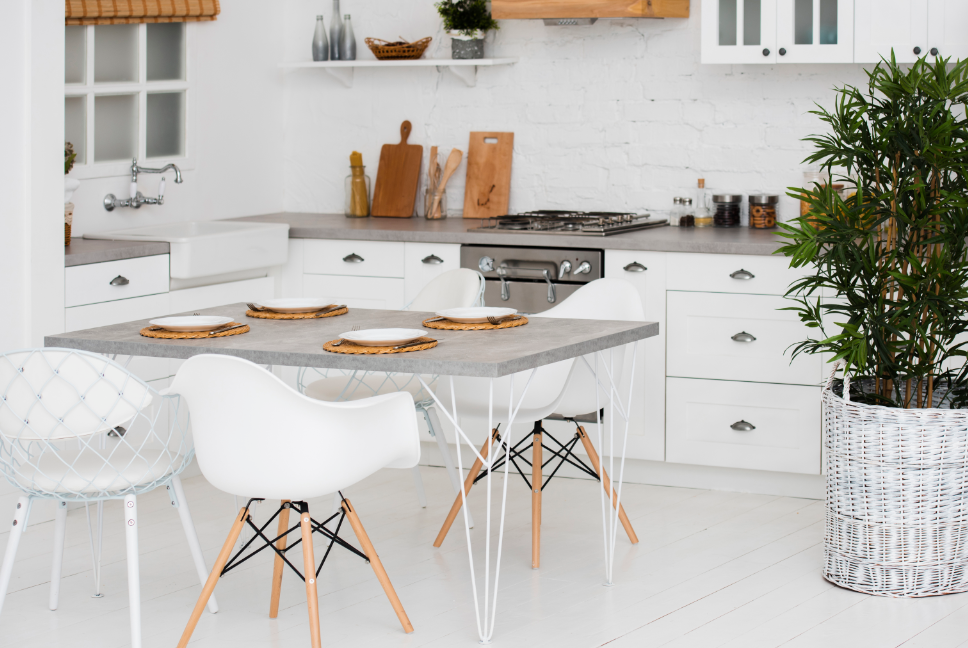
Going green has gone mainstream. More homeowners are looking for ways to jump on the sustainability bandwagon and do their part to help save the planet. The home improvement market has listened to this demand and has begun adding an array of green and eco-friendly materials and options to their repertoire.
When it comes to remodeling your kitchen, there’s no shortage of eco-friendly projects to help get your kitchen looking fantastic while being eco-aware in the process.
Here are some eco-friendly projects for your kitchen.
Project One: Optimize Energy Efficiency
The first project for any eco-friendly remodel should focus on optimizing energy efficiency. Kitchens aren’t the most energy-efficient rooms in the home, but some upgrades and changes can help make your kitchen more energy-efficient.
Start by improving the insulation and weatherproofing windows and doors. This ensures that you aren’t wasting money on heating and cooling the kitchen. Then, swap out your bulbs, windows, and appliances for energy-efficient models. Look for EnergyStar ratings and go for products with more stars.
Project Two: Re-do the Floors with Eco-Friendly Materials
Almost every room remodel includes a flooring upgrade, but the standard options for flooring won’t do in an eco-friendly kitchen. Instead, choose flooring options like bamboo, reclaimed or recycled wood, concrete, recycled tiles, and sustainable cork – these are all stellar choices.
Look for material manufacturers who promote their sustainability practices so that you’re sure you end up with an eco-friendly and ethically sourced material.
Project Three: Install a New Green Countertop
We aren’t talking about the color green here. However, if you like the color green, go for it. Instead, we’re talking materials again. Just like with flooring, several countertop options on the market aren’t environmentally friendly. However, several options fit the bill.
Some options include recycled glass, reclaimed wood, paper composite, bamboo, aluminum, and quartz. While the cost of quartz countertops can be a bit higher than others on the list, it’s a material that’s both eco-friendly and widely used across the market – not just by environmentally-conscious consumers.
Project Four: Add in a Recycling Station
When most homeowners go green, they adjust their lifestyle habits, too. One of those habits is recycling. However, most kitchens only come equipped with a place for a trash can. Consider adding a rolling nook for your recycling bin or creating another area to put your recycled waste.
If you’re also composting, consider adding an in-counter compost bin, too, so that you don’t have an unsightly compost bucket on display in your kitchen.
Project Five: Upgrade the Cabinets
Most cabinets are made of wood. Sometimes that wood is reclaimed, but you still need to do a bit of investigating to ensure that the glue they used doesn’t include formaldehyde. Most commercially available cabinets are made of pressed wood, particleboard, plywood, and all of these typically don’t use formaldehyde-free glues.
When shopping for cabinets, look for those that are FSC-certified. This ensures that they use safe, non-toxic materials in the wood. Alternatively, if you don’t want wooden cabinets, go for concrete or bamboo cabinets instead.
Project Six: Regulate Your Water Usage
Take time to change out your faucets to low-flow alternatives. This allows you to control your water usage in your kitchen effectively. Consider looking into dishwashers that use less water, too.
While we’re on the topic of water, you can even consider incorporating a filter onto your faucet to make your sink water safe to drink. If you live in an area where the sink water is already purified, then this one doesn’t apply to you. However, if it does apply, this addition will help eliminate water bottle usage in your home.
Final Tips Before Starting Your Eco-Friendly Kitchen Remodel
These remodeling projects are fantastic places to make your kitchen eco-friendly. If you’re hiring a contractor for any of the work, be sure to look for one who has worked on eco-friendly projects before.
Beyond that, do your research on all the products and materials you plan to use. Sometimes chemicals or non-sustainable practices aren’t visible right away, so you’ll have to dig a little deeper.
Remember, that to truly go green, you not only have to make changes like these, but you also have to change your daily habits. Start taking steps today towards your kitchen remodel, and you’ll be well on your way to going green and living a truly eco-friendly lifestyle.
Written by Matt Lee
About the Author
Matt Lee is the owner of the Innovative Building Materials blog and a content writer for the building materials industry. He is focused on helping fellow homeowners, contractors, and architects discover materials and methods of construction that save money, improve energy efficiency, and increase property value.
You may also like
Choosing Energy-Efficient Windows for Ultimate Sustainability
Simple and Natural Ways to Clean Hardwood Flooring
Things to Consider When Choosing Energy-Efficient Windows for Your Home
Eco-Friendly Plumbing Priorities Before You Leave for Vacation
